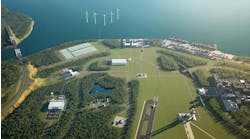AUSTIN, Texas — Turning the Gulf of Mexico into a long-term source for fresh drinking water is the focus of an unprecedented study Texas Land Commissioner Jerry Patterson and the Guadalupe-Blanco River Authority (GBRA) agreed to begin on April 15.The $2-million effort will investigate the feasibility of building a natural gas-fired power plant next to a seawater desalination facility along the Texas Gulf Coast to produce both electricity and fresh water for Texans. Both are vital to keep up with Texas' steady growth."Texas needs water, and Texas needs electricity," Patterson said. "This idea has exciting potential to bring both a sustainable source of water and power to Texans who need it most."Creating an additional source of water on the Texas Gulf Coast is vital to maintaining the region's current industries, as well as encouraging new ones to relocate to the region, Patterson said. The Texas Legislature concurs, as evidenced by House Concurrent Resolution 59, which calls for an interim committee to study seawater desalination on the Texas coast. Patterson hopes his initiative with GBRA will help jump-start this process and lead to greater understanding of the role seawater desalination will play in Texas' future.A March 18, 2013, article by Joel Kotkin in Forbes magazine noted, "Growth momentum has shifted decidedly toward Texas. Austin's population expanded a remarkable three percent last year, tops among the nation's 52 largest metro areas. Three other Lone Star metropolitan areas — Houston, San Antonio, Dallas-Fort Worth — ranked in the top six and all expanded at roughly twice the national average."Also, developing an entirely new source of fresh water is more important than ever in light of recent legal decisions related to the endangered whooping crane that will make it harder than ever to acquire surface water rights in the region.GBRA proposes the building of a 500-MW natural gas-fired power plant next to a desalination facility that would process from 25 to 50 million gallons of seawater per day into fresh drinking water — enough to supply the typical water usage for more than 125,000 homes."Texas must address both its water and energy challenges to maximize the opportunities coming our way," said GBRA General Manager W.E. "Bill" West, Jr. "We believe this project has the potential to jump-start or accommodate a growing population, economic development, agriculture and environmental needs."The General Land Office and the Guadalupe-Blanco River Authority are now working to evaluate proposals from engineering and consulting firms from across the world to conduct the research. The study is anticipated to take as long as two years and will be conducted in four general phases that include financial, technical, integration and distribution evaluations of the proposed project.As Texas enters its third year of drought, finding new sources of water is vital, Patterson said. "All the river basin rights are essentially fully allocated, and it takes decades to create a new surface reservoir — but every day the demand grows," Patterson said. "The Gulf might just be an affordable, sustainable water resource we can add to the mix to help alleviate the pressure upstream."Seawater desalination is an energy-intensive process, and the co-location of a power plant will allow for a reliable and inexpensive power supply, making the overall project far more cost-competitive. # # #
Latest from Industry News
Latest from Industry News



